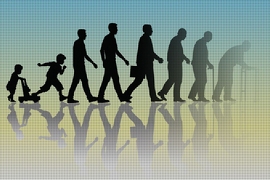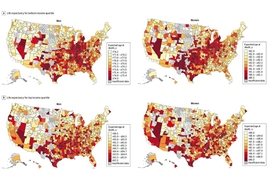Poverty in the U.S. is often associated with deprivation, in areas including housing, employment, and education. Now a study co-authored by two MIT researchers has shown, in unprecedented geographic detail, another stark reality: Poor people live shorter lives, too.
More precisely, the study shows that in the U.S., the richest 1 percent of men lives 14.6 years longer on average than the poorest 1 percent of men, while among women in those wealth percentiles, the difference is 10.1 years on average.
This eye-opening gap is also growing rapidly: Over roughly the last 15 years, life expectancy increased by 2.34 years for men and 2.91 years for women who are among the top 5 percent of income earners in America, but by just 0.32 and 0.04 years for men and women in the bottom 5 percent of the income tables.
“When we think about income inequality in the United States, we think that low-income Americans can’t afford to purchase the same homes, live in the same neighborhoods, and buy the same goods and services as higher-income Americans,” says Michael Stepner, a PhD candidate in MIT’s Department of Economics. “But the fact that they can on average expect to have 10 or 15 fewer years of life really demonstrates the level of inequality we’ve had in the United States.”
Stepner and Sarah Abraham, another PhD candidate in MIT’s Department of Economics, are among the co-authors of a newly published paper summarizing the study’s findings, and have played central roles in a three-year research project establishing the results.
In addition to reporting the size and growth of the income gap, the study finds that the average lifespan varies considerably by region in the U.S. (by as much as 4.5 years), but that the sources of that regional variation are subtle, and, like the aggregate national gap, subject to further investigation.
“The patterns are not exactly what you might expect,” says Abraham, noting that regional variation in longevity does not seem strongly correlated with factors such as access to health care, environmental issues, income inequality, or the job market.
“We don’t find those to be as highly correlated with differences in longevity as we find measures of health behavior, such as smoking rates or obesity rates” [to be correlated with lifespan], Abraham observes.
The paper, “The Association between Income and Life Expectancy in the United States, 2001-2014,” is being published today by the Journal of the American Medical Association.
The authors are Raj Chetty, a professor of economics at Stanford University; Stepner and Abraham of MIT, who are the second and third authors on the paper; Shelby Lin, an analyst with McKinsey and Company in New York; Benjamin Scuderi, a predoctorate fellow in Harvard University’s Economics Department; Augustin Bergeron, a PhD candidate in Harvard University’s Economics Department; Nicholas Turner of the Office of Tax Analysis in the U.S. Department of the Treasury; and David Cutler, a professor of economics at Harvard University.
The geography of mortality
The researchers looked at 1.4 billion anonymized income tax filings from the federal government, and combined that with mortality data from the years 2001 through 2014 from the Social Security Administration. This represents the most complete geographic and demographic landscape of mortality in America.
Among other things, the growth of the gap in mortality rates — by nearly three years — struck the researchers as noteworthy. To put it in perspective, they note that federal health officials estimate that curing all forms of cancer would add three years to the average lifespan.
“That change over the last 15 years is the equivalent of the richest Americans winning the war on cancer,” Stepner observes.
At the same time, the researchers are quick to point out that the findings cannot immediately be reduced to simple cause-and-effect explanations. For instance, as social scientists have long observed, it is very hard to say whether having wealth leads to better health — or if health, on aggregate, is a prerequisite for accumulating wealth. Most likely, the two interact in complex ways, something the study cannot resolve.
“It’s a descriptive story,” Stepner says of the data.
A new puzzle emerging from the study, the authors note, is that differences in lifespan exist along the entire continuum of wealth in the U.S.; it is not as if, say, the top 10 percent of earners cluster around identical average lifespans.
“As you go up in the income distribution, life expectancy continues to increase, at every point,” Stepner says.
And then there are the new geographic patterns in the findings. For instance: Eight of the 10 states with the lowest life expectancies for people in the bottom income quartile form a contiguous belt, curving around from Michigan through Ohio, Indiana, Kentucky, Tennessee, Arkansas, Oklahoma, and Kansas.
So while average lifespans for everyone are lower in some Southern states, the poor do not fare worse in those places than they do in other regions.
“The Deep South is the lowest-income area in America, but when we’re looking at life expectancy conditional on having a low income, it’s not worse to be poor in the Deep South than it is in other areas of America,” Stepner says. “It’s just that there are far more poor people living in the South.”
Future research: Think local
The researchers say that more analysis on the sources of local variation in lifespans could be among the most fruitful research areas stemming from the current paper. The research team is releasing all the data from the study today as well.
Among the municipalities where low-income people have experienced the greatest increases in lifespan from 2001-2014, for example, are Toms River, New Jersey; Birmingham, Alabama; and Richmond, Virginia. Cities with the largest drops in lifespan among the poor are Tampa and Pensacola, Florida; and Knoxville, Tennessee.
“We’re not making any normative statements about what policy should be, but there is a wide dispersion of [results] happening in the U.S.,” Abraham says. “That might need to be addressed at a more granular level.”
Places with the overall longest lifespans for the poor include New York City, with a chart-topping 81.8 years on average, as well as a passel of cities in California. The bottom of that list includes Gary, Indiana (77.4 years on average); Las Vegas; and Oklahoma City.
Among the top income earners, people live longest in Salt Lake City (87.8 years on average); Portland, Maine; and Spokane, Washington. The rich have the shortest lives in Las Vegas (84.1 years on average); Gary, Indiana; and Honolulu.
Abraham also observes that the findings could have implications for national policy programs, as well.
“Things like Social Security aren’t going to be as redistributive if the richer people are getting paid for 10 more years than the poorer people,” she says.
Overall, the researchers say they hope to spark a larger discussion among the research and policy communities.
“We don’t have all the answers,” Abraham says. “But it’s really important to make these statistics widely used so people have an idea of what the magnitude of these problems is, where they might focus their attention, and why this matters.”
The research was supported by a grant from the U.S. Social Security Administration to the National Bureau of Economic Research; the National Institutes of Health; the Social Sciences and Humanities Research Council of Canada; the Smith Richardson Foundation; and the Laura and John Arnold Foundation.












